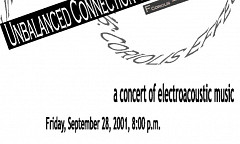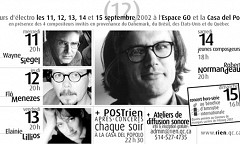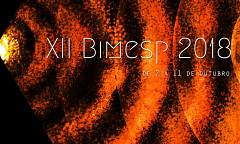
Sinfonias
Flô Menezes
Sinfonias has been performed in Gainesville, Montréal and São Paulo…
Sinfonias (= Symphonies) for electroacoustic sounds is conceived for eight groups of loudspeakers placed around the public. The piece can be considered as made with techniques that are to be classified between the techniques of synthesis and those of sound treatment. It deals in radical and typical manner with techniques of resynthesis, that is, a synthesis obtained through a detailed computer analysis of available samples. Its sound material is exclusively formed by symphonic agglomerates of the 20th Century, which do not surpass the duration of about 2 or 3 seconds. The only exception being the Symphonies pour Instruments à Vent by Stravinsky, which were entirely analysed and subsequently submitted to the utmost transformational procedures.
The work does not, therefore, deal with “musical quotation” so much so that all musical references are here categorically and intentionally hidden. The orchestral extracts have served exclusively as sound material of departure to a compositional process which did not intended to preserve any kind of literal reference beyond the high density of the agglomerates as well as the energy of orchestral timbres. We could metaphorically establish a correlation between the compositional methods in Sinfonias and those related to the dynamization process of homeopathy, since through the transformation of the transformation of the transformation, in a sequence often ranging from seven to eight transformational procedures for each sound sample, the result obtained is nothing more than the pure energy of the sound sources, completely unrecognizable.
Sinfonias pays tribute to the 70 years of Karlheinz Stockhausen. Although indirectly, it makes reference to his work in different aspects. More precisely, several examples could be highlighted: 1) the piece tries to integrate in its musical discourses very short sounds with very long ones — a preoccupation that built a constant in the work of Stockhausen since Kontrapunkte; 2) the original version of Sinfonias is conceived for 8 channels as Oktophonie; 3) its form is organised in two blocks lasting about 8’+ 5’, whose time proportion is related to the Fibonacci-Series (which were used in many ways in the works of Stockhausen); 4) the lengthy silence between the two formal blocks can be related to the dramatic silence in the course of Trans; 5) the vocalic formants that appear after such silence, reminiscent of the formantic song and atmosphere of Stimmung (although in Sinfonias they derived from successive transformational procedures of an orchestral extract from the First Movement of the Ninth Symphony of Mahler!); 6) the total timing of Sinfonias is related to the global duration of Gesang der Jünglinge; 7) its end refers clearly to the polarization of high frequencies in the final moments of Kontakte; and so on.
Sinfonias highlights the simultaneity of sound layers as well as the complexity of sound textures resulting from the transformational procedures employed as its principal sound feature.
[source: Réseaux des arts médiatiques]
Details
Calendar
-
Friday, September 28, 2001Gainesville (Florida, USA)
-
Thursday, September 12, 2002Montréal (Québec)
-
Wednesday, October 3, 2018São Paulo (Brazil)


